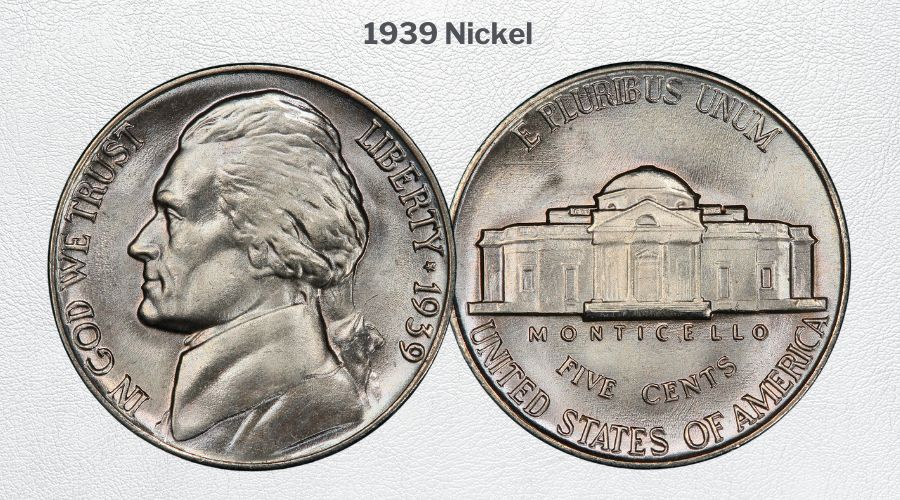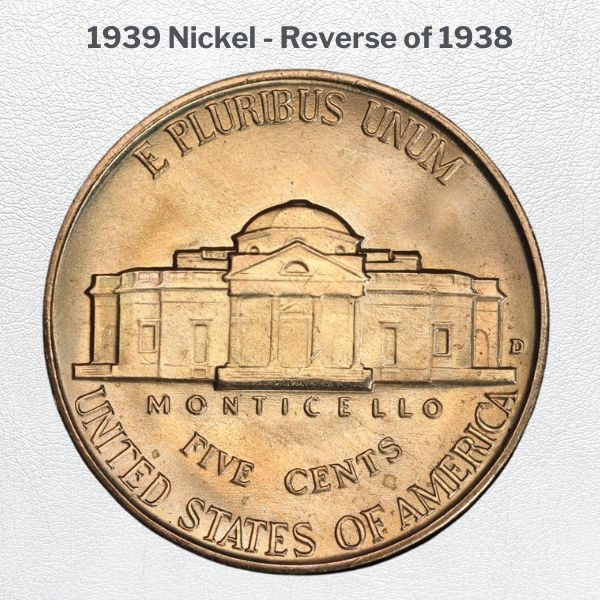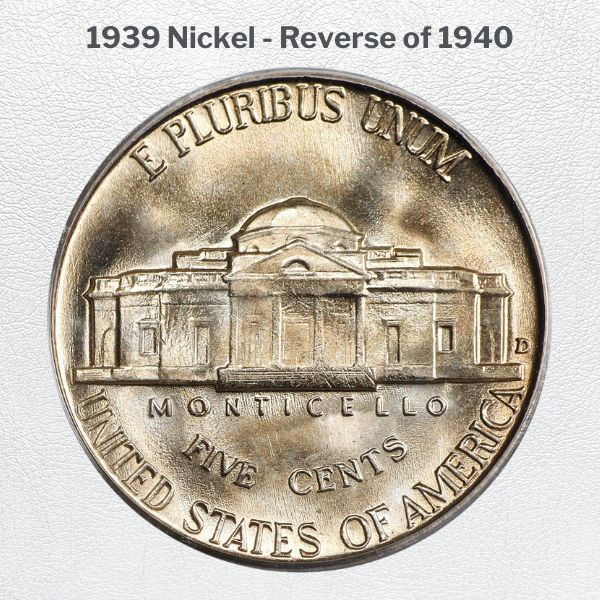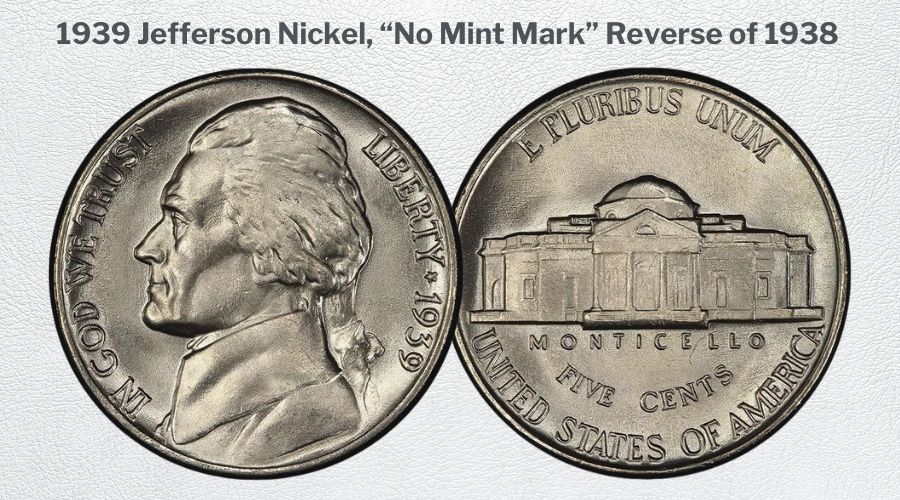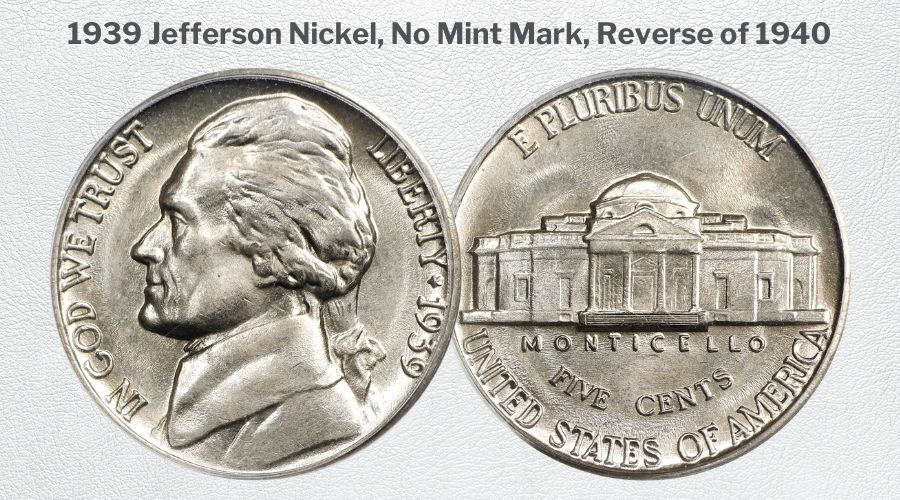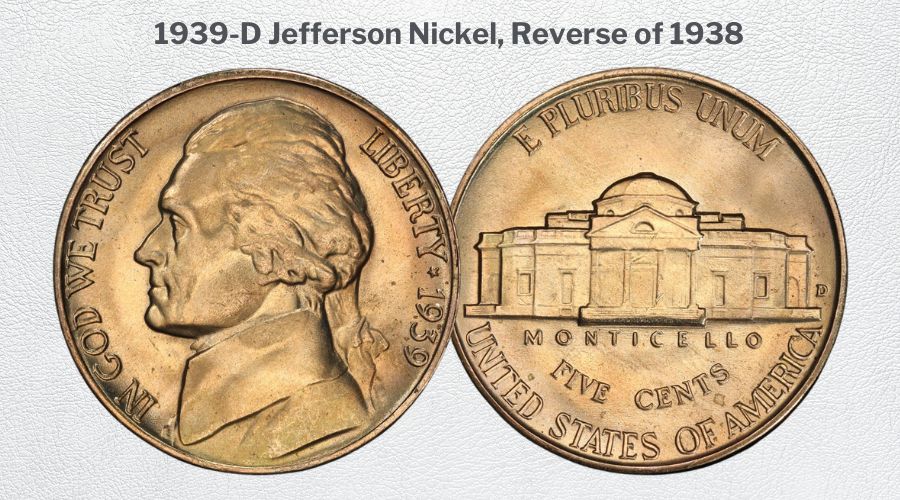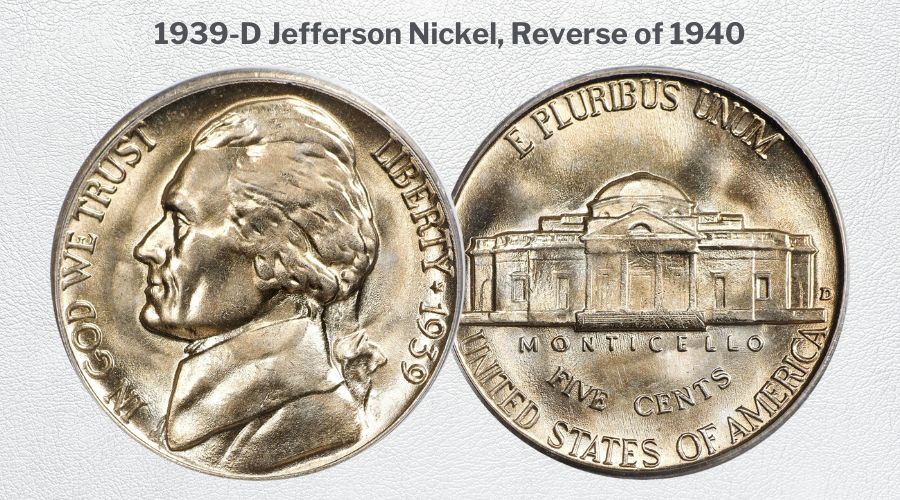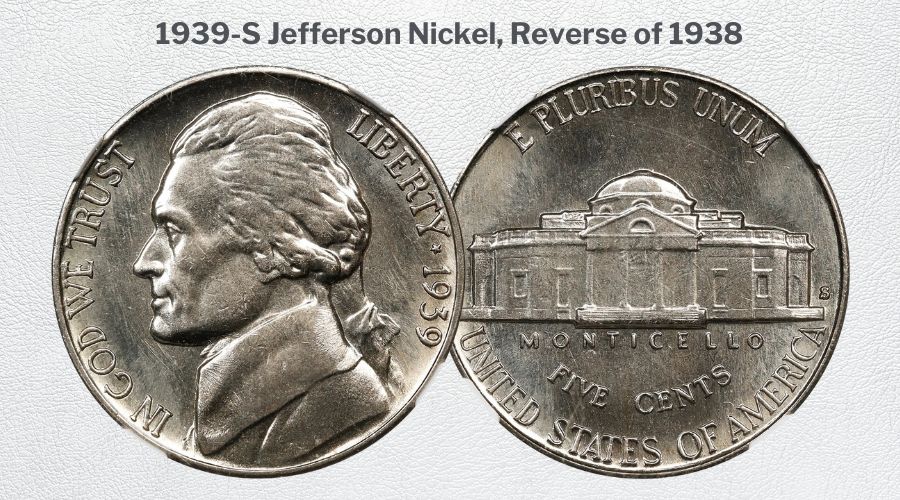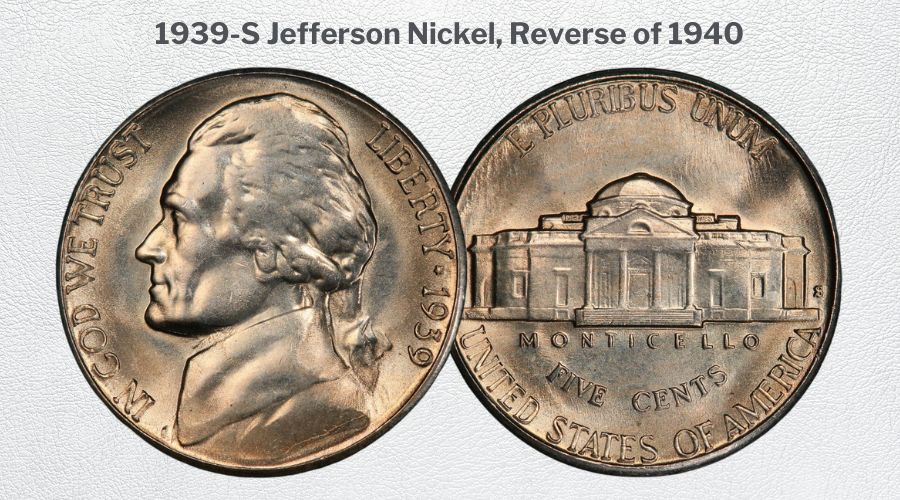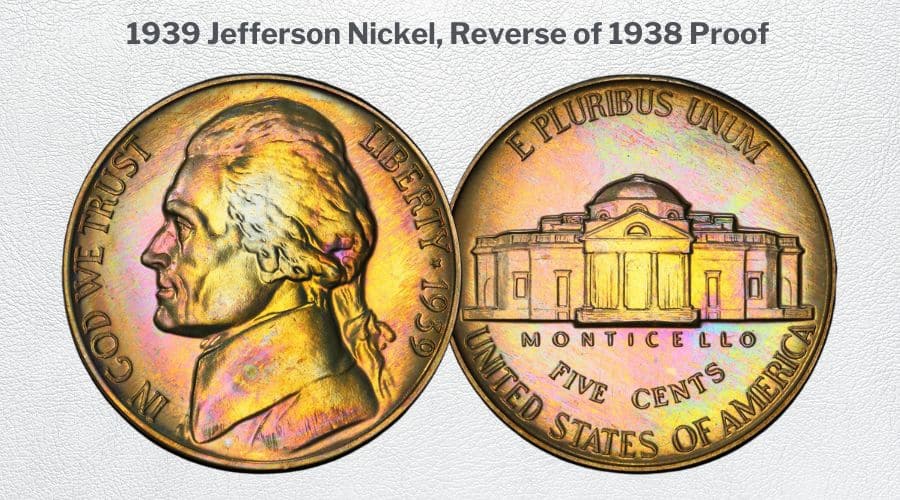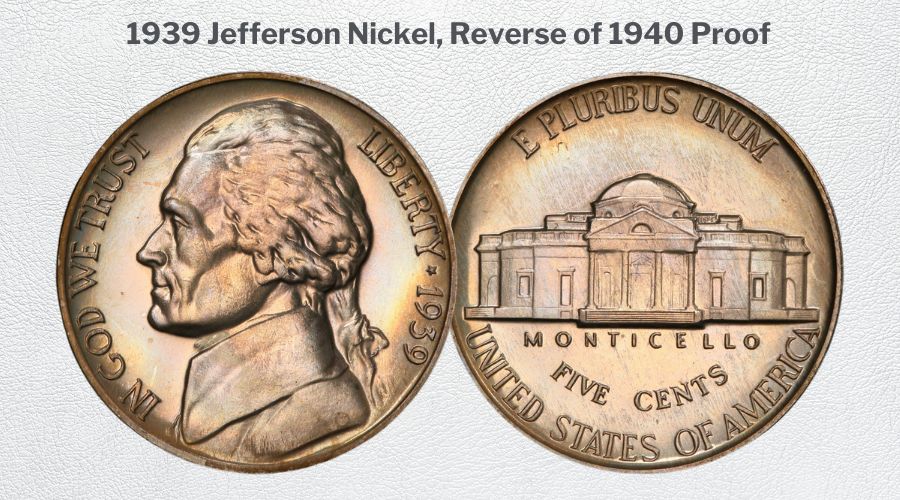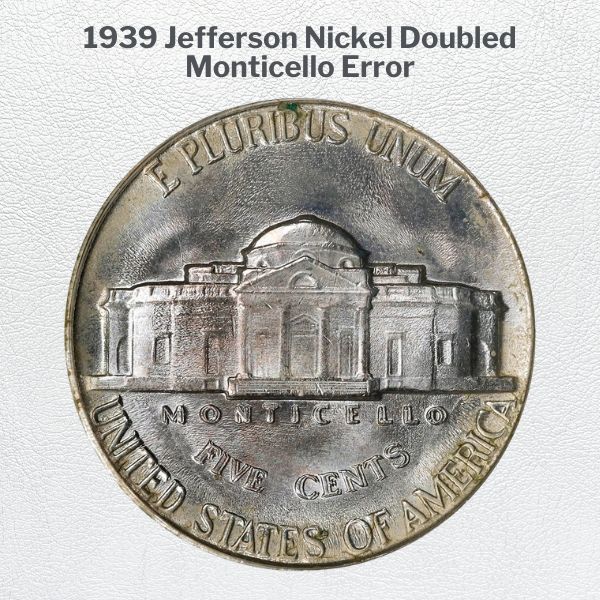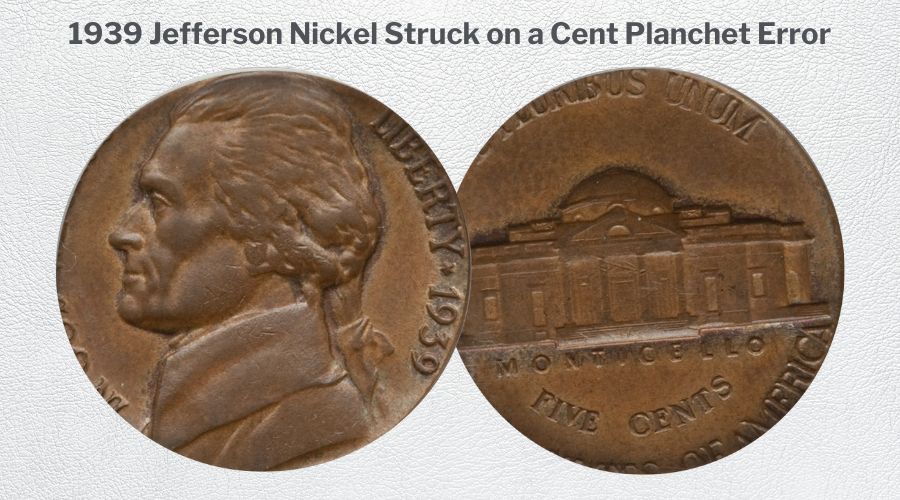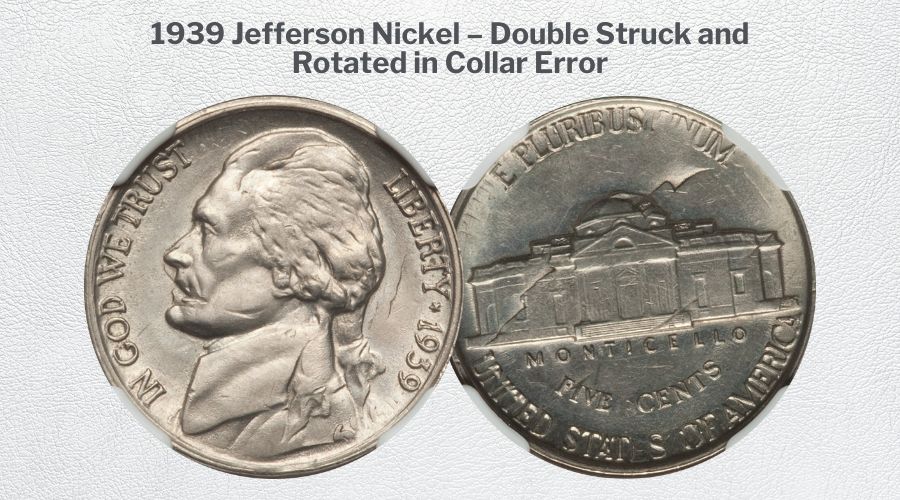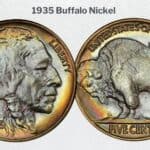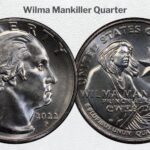Would you consider holding on to a coin with a face value of $0.05? How about a melt value of $0.0525? Anyway, it is just a combination of 25% nickel and 75% copper, right?
However, what if we tell you that someone bagged $23,500 for a rare variety of the same coin?
Believe it or not, a 1939 Doubled Monticello variety sold for the aforementioned amount at the Legend Rare Coin Auctions. That was back in 2019, with a Mint State (MS) of 67, coupled with full steps.
Yes, we are talking about the 1939 Jefferson nickel. A coin whose value does not lie in its metal composition, rather, in the condition and rarity of the variety you hold. Not forgetting, its historical significance in the Jefferson coin series contributes to the value variations.
Keep reading to discover how the 1939 nickel’s value went from mediocre to jaw-dropping. And, if you are wondering what “full steps” have to do with a coin, don’t stress. We’ve got you covered!
1939 Nickel Details
- Category: Jefferson Five Cents (1938-Date)
- Mints: Philadelphia, Denver, San Francisco
- Mintage: 130,759,000
- Obverse Designer: Felix Schlag
- Reverse Designer: Felix Schlag
- Composition: Copper-Nickel
- Weight: 5g
- Diameter: 21.2mm
- Edge: Plain
What is the History Behind the 1939 Jefferson Nickel?
The story of this majestic coin takes us back to 1938. After a mandatory 25-year reign, it was time to drop the buffalo nickel. So, designers went head-on, competing to come up with a novel nickel design to replace the buffalo nickel.
Felix Schlag, a renowned designer came out on top of the design competition. He was to deliver a completely new reverse design and make other critical changes to the new nickel design before October 1938, the planned production month.
The designer adopted the portrait of the third President of the U.S. Thomas Jefferson for the obverse of the new nickel. The backside of the coin features Jefferson’s Monticello home.
These new coins replaced the popular and well-designed Buffalo Nickel in October 1938. However, the 1939 nickel was the hallmark of the Jefferson nickel series because it was the first full-year coin in the Jefferson series.
In addition, major design flaws were corrected in early and late 1939, giving way for the Jefferson nickel’s solid foundation, to date.
1939 Jefferson Nickel Design
The 1938 nickel design marked the start of reserving a historical moment. With the engraving of Thomas Jefferson’s face on the obverse, the nickel won the hearts of many Americans.
Moving on to 1939, mints continued using the 1938 design of the Jefferson nickel. However, there were some design flaws, especially on the reverse.
Jefferson’s Virginia Estate, the Monticello, was less detailed and small. So, corrections had to be made, leading to the categorization of the 1939 nickel into two general design groups:
The 1939 Nickel – Reverse of 1938
The nickels under this category have the original 1938 design. Thus, the name, “reverse of 1938.” On the reverse, the Monticello steps appear to be wavy rather than sharp and distinct. Moreover, the steps have uneven thickness.
It is difficult to define the start or end of the Monticello steps on the reverse of the nickel. This is because of the uneven length of the steps, with some appearing to be longer than others.
The 1939 Nickel – Reverse of 1940
The nickels under this category feature the corrections made to the 1938 Jefferson nickel design. In the early parts of 1939, mints made changes to the reverse design, and close to the end of 1939, they revised the obverse of the nickel.
Rather than using the name, “Reverse of 1939,” the designers opted for “Reverse of 1940” to avoid confusion. It also made it easier for coin collectors and numismatists to distinguish the coin designs.
The Monticello was now relatively bigger and more detailed compared to the one on the 1939 nickel, the reverse of 1938 coins. Moreover, a vertical indentation was placed on the sides of the steps to distinguish the start and end of the steps.
After the change in design, collectors went hunting for coins with full steps. Such coins are rare and are mostly found in the most pristine mint state.
Additional Design Details of the 1939 Jefferson Nickel
Obverse
- IN GOD WE TRUST – Jefferson faces this inscription.
- LIBERTY*1939 – Aligned behind Jefferson.
- E PLURIBUS UNUM – Above the Monticello.
Reverse
- MONTICELLO – Right below the Monticello.
- FIVE CENTS – Follows the Monticello legend.
- UNITED STATES OF AMERICA – Aligned along the rim of the coin, that’s directly below the Monticello building.
Surprisingly, sources dating back to 1938 and 1939 tell how the early batch of the Jefferson nickels was hoarded. Rather than spending the earlier production of the coins, people hid them. Doing so led to a scarcity in supply.
1939 Jefferson Nickel Mintage
All the 1939 Jefferson nickels were either minted in Philadelphia, Denver, or San Francisco. The two designs of the coins were struck in the authorized mints. This led to a wide array of 1939 nickel varieties.
Here is a table highlighting the number of coins minted and the mint marks.
| Mint | Mint Mark | Mintage |
| Philadelphia | N/A | 120,615,000 |
| Denver | D | 3,514,000 |
| San Francisco | S | 6,630,000 |
| Total | 130,759,000 |
1939 Jefferson Nickel Coin Varieties and Value
Many of the 1939 Jefferson nickels are currently held by collectors. You are less likely to find this nickel in circulation. Currently, coin experts or numismatists mainly derive the value of the 1939 nickel by grading it.
Grading involves evaluating the physical condition or state of a coin. The Sheldon grading scale is used to determine the grade of a coin. By assessing and analyzing the coin’s luster, color, toning, strikes, scratches, and attractiveness, a coin expert can determine where the coin lies on the grading scale.
With that aside, here is an elaborate overview of the value of each 1939 nickel variety based on the Sheldon grading scale:
| 1939 Jefferson Nickel Value Chart | ||||
| Variety | Condition | |||
| Circulated | About Uncirculated (A50 – A58) | MS60 – MS64 | MS65 – MS70 | |
| 1939 Jefferson Nickel, ‘No Mint Mark,’ Reverse of 1938 | $0.10 – $0.25 | $1.90 – $2.10 | $3 – $25 | $30 – $1350 |
| 1939 Jefferson Nickel, ‘No Mint Mark,’ Reverse of 1940 | $0.10 – $0.75 | $1.10 – $2.10 | $8 – $30 | $40 – $600 |
| 1939-S Jefferson Nickel, Reverse of 1938 | $0.70 – $2 | $9 – $11 | $20 – $50 | $65 – $250 |
|
1939-S Jefferson Nickel, Reverse of 1940 |
$0.45 – $3 | $6 – $11 | $18 – $50 | $85 – $150 |
| 1939-D Jefferson Nickel, Reverse of 1938 | $3 – $14 | $27.50 – $40 | $45 – $65 | $75 – $1500 |
| 1939-D Jefferson Nickel, Reverse of 1940 | $3 – $14 | $28 – $40 | $45 – $65 | $85 – $700 |
| PR60 – PR62 | PR63-PR65 | PR66-PR68 | PR69++ | |
| 1939 Jefferson Nickel, Reverse of 1938 Proof | $30 – $50 | $60 – $130 | $145 – $5500 | – |
| 1939 Jefferson Nickel, Reverse of 1940 Proof | $30 – $60 | $75 – $250 | $750 – $12750 | – |
As you can see, the values are in ranges. This is because there is no fixed price for a specific coin. The values change regularly, with various certified graders like PCGS and NGC Coin Explorer working tirelessly to ensure the utmost accurate grading and valuation.
What is the Value of the 1939 Nickel Varieties?
Well, to ease the process of approximating the value of your 1939 nickel before you even submit it for official grading and valuation, here is a quick review of each variety. Get to understand how each variety looks like and the approximate amount you can collect for the coin at an auction.
As mentioned earlier, the three mints produced the two designs of the 1939 nickel. And doing so yielded several varieties. Here is a breakdown of the design differences for each variety produced by the mints:
1939 Jefferson Nickel, No Mint Mark
These coins were struck by the Philadelphia Mint and had no special mark on them. The Mint struck two varieties including:
1. 1939 Jefferson Nickel, “No Mint Mark” Reverse of 1938
Even though a total of 120,615,000 coins were minted, only a few had the 1938 design. So, this kind of coin is currently scarce, meaning you can get more for it at an auction compared to selling at its approximate value as indicated in the value table.
The greatest auction record for this coin is $5,287.50. This 1939 nickel, with an MS67+ grade was sold at Heritage Auctions on 02/27/2014. Here is a table of current auction sales:
| Grade | Price | Firm | Sale Date |
| MS67+FS | $3,525 | Legend Rare Coin Auctions | Jul-2020 |
| MS67FS | $1,800 | Stack’s Bowers | Aug-2021 |
| MS66FS | $360 | Heritage Auctions | Oct-2020 |
| MS67 | $144 | Heritage Auctions | Mar-2021 |
| MS67 | $65 | David Lawrence RC | Dec-2022 |
2. 1939 Jefferson Nickel, No Mint Mark, Reverse of 1940
Despite being abundant across all the 1939 nickel grades, pieces with full steps are usually pricier.
When a coin has full steps, it means the Monticello steps are well-defined and distinct. None of the steps is broken and you can count them. Finding such a coin, especially one with a rare error can fetch you a huge amount in the open market.
The full-steps coins take a configuration of either 5FS or 6FS, making them rare. Here is a brief record of top auction prices for the coin:
| Grade | Price | Firm | Sale Date |
| MS67FS | $336 | Stack’s Bowers | Apr-2023 |
| MS67FS | $216 | Heritage Auctions | Mar-2023 |
| MS67FS | $100 | David Lawrence | Mar-2023 |
| MS67 | $99 | Heritage Auctions | Apr-2023 |
1939-D Nickel
The letter “D” on the reverse of this nickel means it was minted in Denver. Observe the left side of the back of the 1939-D coin and you will notice a “D” on the left side of the Monticello. The two varieties minted in Denver include:
1. Jefferson Nickel, 1939-D Reverse of 1938
Even though the Denver mint produced close to 876,000 reverse of 1938 coins, they still rank in the Jefferson series as the second least minted coins. If you happen to have a 5FS (Full Step) variant of this coin, you might have just won the jackpot because it is quite rare. Here is a look at what you can get at an auction.
| Grade | Price | Firm | Sale Date |
| MS67 | $154 | Heritage Auctions | Feb-2023 |
| MS67 | $120 | Heritage Auctions | May-2023 |
| MS67 | $119 | Heritage Auctions | Aug-2023 |
| MS66 | $111 | Heritage Auctions | Mar-2023 |
| MS67 | $109 | Heritage Auctions | Jan-2023 |
2. Jefferson Nickel, 1939-D Reverse of 1940
Mint state 1939-D reverse of 1940 coins are quite rare. This is because of the low number of coins minted in Denver. Also, many of the coins minted in Denver are regarded as gems because of how well they were made.
So, if you were to find a rare coin like the one with 5FS, you’d be in for a great return. Check out the recent auction prices of this coin according to sales records.
| Grade | Price | Firm | Sale Date |
| MS67 | $264 | Stack’s Bowers | Apr-2023 |
| MS67+ | $244 | Heritage Auctions | May-2023 |
| MS67 | $228 | Heritage Auctions | May-2023 |
| MS67+ | $216 | Heritage Auctions | March-2023 |
1939-S Nickel
The 1939-S nickel variant was struck in San Francisco. Just like the 1939-D nickel, the coins have an “S” mint mark and include two varieties:
1. 1939-S Jefferson Nickel, Reverse of 1938
About 2/3 of the 1939-S coins fall under the reverse of 1938 category. So, there are little to no gems. However, if you can find a 5FS variant of this coin, you can sell it at a way higher price than these auction sales:
| Grade | Price | Firm | Sale Date |
| MS67FS | $660 | Stack’s Bowers | Mar-2023 |
| MS66 | $228 | Heritage Auctions | May-2023 |
| MS67 | $180 | Heritage Auctions | May-2023 |
| MS67 | $168 | Stack’s Bowers | Apr-2023 |
| MS66 | $67 | Heritage Auctions | May-2023 |
2. 1939-S Jefferson Nickel, Reverse of 1940
Just like the reverse of 1938 coins, these variants rarely sell at a greater price, unless in pristine condition. Moreover, the production of these coins was inconsistent, with many of the coins having weak details and poor luster.
| Grade | Price | Firm | Sale Date |
| MS66+FS | $1621 | Heritage Auctions | Feb-2022 |
| MS66FS | $504 | Heritage Auctions | May-2023 |
| MS66FS | $432 | Heritage Auctions | Feb-2022 |
| MS65FS | $210 | David Lawrence RC | Dec-2022 |
| MS66 | $168 | Stack’s Bowers | Aug-2023 |
1939 Jefferson Nickel, Proof Coins
The US Mint struck around 12,535 Jefferson Nickel proof coins in Philadelphia in 1939. However, there was no speculative frenzy over these issues. These nickels were characterized into two categories:
1. 1939 Jefferson Nickel, Reverse of 1938 Proof
Proofs are often produced for collectors and investors, so they tend to have a unique mirror like appearance with sharp details.
The 1939 Jefferson Nickels with the reverse of 1938 are not so different from other proofs produced by the US Mint. The difference is that the workers at the Philadelphia minting facility did not use a reverse hub with sharp details for the Monticello design.
These proof nickels fairly common from PR60 to PR66 and can sell for anywhere between $30 to $145. As you move to PR67, the proof coins thin and become rare, particularly Cameo pieces.
Sales records show that such a coin can trade for as much as $1,323.
Here’s the table showing the recent prices these proof nickels sold for.
| Grade | Price | Firm | Sale Date |
| PR64 | $252 | Heritage Auctions | Jun-2023 |
| PR67 | $384 | Stack’s Bowers | Jun-2023 |
| PR68 | $1,980 | Heritage Auctions | Jul-2023 |
| PR68 | $3,000 | Heritage Auctions | Dec-2023 |
2. 1939 Jefferson Nickel, Reverse of 1940 Proof
The only difference between the proofs with the 1938 reverse and those with the 1940 reverse is that the latter show sharp and distinct steps of the Monticello.
Unlike its predecessor the proof Jefferson Nickel with a reverse of 1940 is quite rare, but very few collectors and coin enthusiasts are aware of its rarity. This is also one of the reasons this coin demands a high premium in auctions – upwards of $10, 350. Other top prices for the proof include the following:
| Grade | Price | Firm | Sale Date |
| PR67 | $1,110 | Heritage Auctions | Dec-2022 |
| PR67 | $2,640 | Heritage Auctions | Apr-2023 |
| PR68 | $15,600 | Heritage Auctions | Jun-2022 |
1939 Jefferson Nickel Errors
The most common error is the 1939 Doubled Monticello. Other errors include the 1939 Jefferson nickel struck on a Cent Planchet and the 1939 Jefferson nickel – Double struck and rotated in collar.
1. 1939 Jefferson Nickel Doubled Monticello
A single double Monticello can sell for upwards of about $23,500 ++. Why? Only close to 1000 of these coins were minted. Moreover, many of them were circulated, meaning uncirculated pieces are rare.
The doubling error is usually on the “Five Cent” and “Monticello ” inscriptions. On close observation, you will realize that the letters were struck twice. Finding a coin with distinctive doubling is rare because many of the 1939 Doubled Monticello coins are of low grades.
Here is a breakdown of the most recent auction sales:
| Grade | Price | Firm | Sale Date |
| MS66FS | $6,900 | Stack’s Bowers | Jun-2023 |
| MS64 | $1,140 | Heritage Auctions | Jun-2023 |
| MS64 | $926 | David Lawrence RC | Mar-2023 |
| AU58 | $220 | David Lawrence RC | Jan-2023 |
| AU55 | $216 | Heritage Auctions | Jul-2023 |
2. 1939 Jefferson Nickel Struck on a Cent Planchet
Rather than being struck onto its original coin planchet, this rare error coin was struck on a cent planchet. The coin in record is golden-brown in color, with the right rim cutting through the inscription: IN GOD WE TRUST. It was sold on the 10th of September, 2019 for $1,560.
3. 1939 Jefferson Nickel – Double Struck and Rotated in Collar
With a combination of two errors on the obverse, this coin sold for $499.38 on the 2nd of March 2014. The obverse has double strikes on the inscriptions, with an evident indentation on Jefferson’s collar, making the collar appear rotated.
Final Words
Set among the first set of Jefferson coins, the 1939 nickel is a true definition of resilience. Starting off with a face value of $0.05 and design issues, the coin has come a long way to rank among the most valuable coins in the Jefferson series.
Many of the 1939 varieties with a higher Mint State (MS) value can sell for quite impressive numbers. Some rare pieces like the Double Monticello can fetch you a fortune – up to 10,000. But first, you have to understand what goes into pricing a coin, including grading and more.
If you have a 1939 nickel, we hope this post has helped you determine what variety you have and its approximate value. Got more questions for us? Don’t hesitate to reach out.

